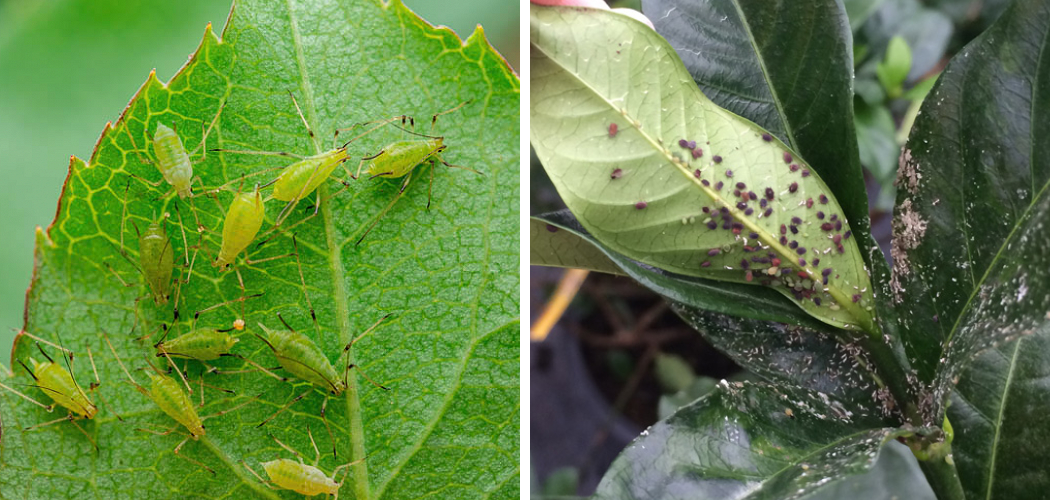To get rid of aphids on gardenias, use a solution of water and dish soap and spray it directly on the affected plants. Gardenias are beautiful flowering plants that add beauty and fragrance to any garden.
However, they are also susceptible to aphid infestations. Aphids, small sap-sucking insects, can quickly multiply and cause damage to the gardenias by sucking the sap out of the leaves and stems. Fortunately, there is a simple and effective method to get rid of aphids on gardenias.
By creating a solution of water and dish soap and applying it directly to the affected plants, you can effectively control the aphid population and protect your gardenias from further damage. In this article, we will explore this method in more detail and provide some additional tips for keeping your gardenias aphid-free.

Why Gardenias Are Affected By Aphids And How To Identify Them
Gardenias can be severely affected by aphids, which are a common problem for these plants. Aphids are tiny insects that are usually green or brown in color and have soft bodies. They feed on the sap of gardenia leaves and stems, causing damage to the plant’s overall health.
To identify aphids on your gardenias, look for clusters of small insects on the undersides of leaves or along the stems. You may also notice sticky, honeydew-like residue on the leaves. To get rid of aphids, you can try various methods such as spraying the affected areas with a strong flow of water, using organic insecticidal soap, or introducing natural predators like ladybugs.
Regularly monitoring your gardenias and taking early action against aphids can help prevent serious damage to your plants.
How to Get Rid of Aphids on Gardenias: Step by Step Guide
Natural Ways To Prevent Aphids On Gardenias
Gardenias are prone to aphid infestations, but there are natural ways to prevent these pests. Encouraging natural predators like ladybugs and lacewings can help control aphid populations. Additionally, companion planting with deterrent plants such as marigolds or garlic can discourage aphids from attacking gardenias.
These plants emit strong scents that repel aphids. Regularly inspecting gardenias for signs of aphids and promptly removing any infested leaves or stems is also important. Additionally, hosing down the plants with a strong jet of water can dislodge and remove aphids.
By implementing these natural methods, gardeners can effectively rid their gardenias of aphids without relying on harmful chemicals. Keeping gardenias healthy and properly pruned will also make them less susceptible to aphid attacks.
Effective Treatments To Get Rid Of Aphids On Gardenias
Tired of dealing with aphids on your beloved gardenias? We’ve got you covered with effective treatments. One solution involves creating a simple soap and water spray. This non-toxic remedy can be easily applied to your gardenias, suffocating the aphids and preventing further infestation.
Another organic option is neem oil, a natural insecticide that disrupts the aphids’ growth and development. Simply mix it with water and spray it on your gardenias for effective control. For those who prefer homemade remedies, a garlic spray can be an excellent choice.

Crush a few garlic cloves, mix with water, strain, and spray it on your gardenias to repel aphids. These treatments are not only affordable but also safe for both your gardenias and the environment. Keep your gardenias aphid-free and thriving with these natural and easy-to-use solutions.
Frequently Asked Questions Of How To Get Rid Of Aphids On Gardenias
How Do I Know If My Gardenias Have Aphids?
Look for curled leaves, sticky residue on leaves and stems, and ants on the plants. These are common signs of aphid infestation on gardenias.
Can I Use Chemical Insecticides To Get Rid Of Aphids On Gardenias?
Yes, but it’s recommended to try organic methods first. Chemical insecticides may harm beneficial insects and can be toxic to humans and pets.
What Are Some Organic Methods To Control Aphids On Gardenias?

Try spraying a mixture of water and dish soap on the plants, using neem oil, or introducing ladybugs to eat the aphids.
How Often Should I Check My Gardenias For Aphids?
It’s a good idea to regularly inspect your gardenias for aphids, especially during spring and summer when they are most active.
Can Aphids Kill My Gardenias?
In severe infestations, aphids can weaken and damage gardenias. If left unchecked, they may cause leaf drop, stunted growth, and even death of the plant. It’s important to control aphids as soon as possible.
Conclusion
To successfully combat aphids on your gardenias, it’s essential to take a holistic approach. By following the strategies mentioned throughout this blog post, you can effectively eliminate these pests and keep your gardenias healthy. Regularly inspecting your plants, employing natural remedies like neem oil or soapy water, and attracting beneficial insects are all crucial steps in aphid control.
Additionally, maintaining proper plant care practices such as proper watering, mulching, and pruning will boost your plants’ resilience against aphid infestation. Remember, prevention is key, so continuously monitoring your gardenias for signs of aphids is crucial. By implementing these techniques, you will not only rid your gardenias of aphids but also create a healthy and thriving garden for years to come.
Embrace these practices, and your gardenias will thank you with their vibrant blooms and pest-free leaves.

